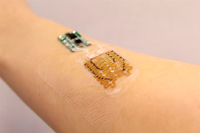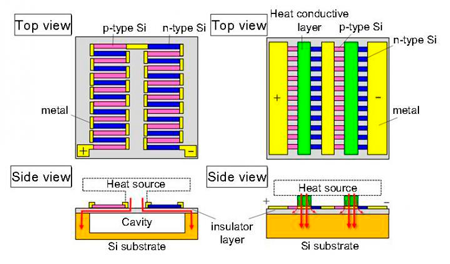Electronics News
Archive : 10 July 2018 год
 Researchers from the University of Maryland claim to have demonstrated the first single-photon transistor using a semiconductor chip.
Researchers from the University of Maryland claim to have demonstrated the first single-photon transistor using a semiconductor chip.
Making a quantum transistor triggered by light has been a previous challenge because it requires that the photons interact with each other, the researchers explain.
According to the team, the device is compact: roughly one million of these new transistors could fit inside a single grain of salt. It is also fast and able to process 10billion photonic qubits every second.
"Using our transistor, we should be able to perform quantum gates between photons," says Professor Edo Waks of the University of Maryland's A. James Clark School of Engineering and Joint Quantum Institute. "Software running on a quantum computer would use a series of such operations to attain exponential speedup for certain computational problems.
The photonic chip is made from a semiconductor with numerous holes in it. Light entering the chip bounces around and gets trapped by the hole pattern; a quantum dot sits inside the area where the light intensity is strongest.
Analogous to conventional computer memory, the dot stores information about photons as they enter the device. The dot can effectively tap into that memory to mediate photon interactions, meaning that the actions of one photon affect others that later arrive at the chip.
"In a single-photon transistor the quantum dot memory must persist long enough to interact with each photonic qubit," says Shuo Sun, lead author of the new work. "This allows a single photon to switch a bigger stream of photons, which is essential for our device to be considered a transistor."
To test that the chip operated like a transistor, the researchers examined how the device responded to weak light pulses that usually contained only one photon. In a normal environment, such dim light might barely register, however, in this device, a single photon gets trapped for a long time, registering its presence in the nearby dot.
The team observed that a single photon could, by interacting with the dot, control the transmission of a second light pulse through the device. The first light pulse acts like a key, opening the door for the second photon to enter the chip. If the first pulse didn't contain any photons, the dot blocked subsequent photons from getting through. This behaviour is similar to a conventional transistor where a small voltage controls the passage of current through its terminals. Here, the researchers successfully replaced the voltage with a single photon and demonstrated that their quantum transistor could switch a light pulse containing around 30 photons before the quantum dot's memory ran out.
Prof Waks says that his team had to test different aspects of the device's performance prior to getting the transistor to work. "Until now, we had the individual components necessary to make a single photon transistor, but here we combined all of the steps into a single chip.”
Sun says that with realistic engineering improvements their approach could allow many quantum light transistors to be linked together. The team hopes that such speedy, highly connected devices will eventually lead to compact quantum computers that process large numbers of photonic qubits.
Author
Bethan Grylls
Source: www.newelectronics.co.uk
 A prototype bandage designed to actively monitor the condition of chronic wounds and deliver appropriate drug treatments to improve the chances of healing has been developed by Tufts University engineers.
A prototype bandage designed to actively monitor the condition of chronic wounds and deliver appropriate drug treatments to improve the chances of healing has been developed by Tufts University engineers.
The researchers designed the bandages with heating elements and thermoresponsive drug carriers that they say can deliver tailored treatments in response to embedded pH and temperature sensors that track infection and inflammation.
The hope is these smart bandages could provide real time monitoring and delivery of treatment with limited intervention from the patient or caregivers.
The pH of a chronic wound is one of the key parameters for monitoring its progress. Normal healing wounds fall within the range of pH 5.5 to 6.5, whereas non-healing infected wounds can have pH well above 6.5.
Temperature is also an important parameter, providing information on the level of inflammation in and around the wound. While the smart bandages in this study combine pH and temperature sensors, Prof Sonkusale and his team of engineers have also developed flexible sensors for oxygenation, which they say can be integrated into the bandage. Inflammation could also be tracked not just by heat, but by specific biomarkers as well.
A microprocessor reads the data from the sensors and can release drug on demand from its carriers by heating the gel. The entire construct is attached to a transparent medical tape to form a flexible bandage less than 3mm thick. Components were selected to keep the bandage low cost and disposable, except for the microprocessor, which can be re-used, says the Tufts team.
The smart bandages have been created and tested successfully under in vitro conditions, the team says. Pre-clinical studies are now underway to determine their in vivo clinical advantages in facilitating healing compared to traditional bandages and wound care products.
Author
Bethan Grylls
Source: www.newelectronics.co.uk
 A silicon-nanowire thermoelectric generator has been developed by a team of researchers from Waseda University, Osaka University, and Shizuoka University.
A silicon-nanowire thermoelectric generator has been developed by a team of researchers from Waseda University, Osaka University, and Shizuoka University.
According to the Japanese researchers, this experimentally demonstrated a high-power density of 12 microwatts per 1cm2, enough to drive sensors or realise intermittent wireless communication, at a small thermal difference of only 5ºC.
Silicon-based thermoelectric generators conventionally employed long, silicon nanowires of about 10-100nm, which were suspended on a cavity to cut off the bypass of the heat current and secure the temperature difference across the silicon nanowires. However, the cavity structure weakened the mechanical strength of the devices and increased the fabrication cost. The team says their generator has overcome this issue.
"Because our generator uses the same technology to manufacture semiconductor integrated circuits, its processing cost could be largely cut through mass production," says Professor Takanobu Watanabe of Waseda University. “Also, it could open up a pathway to various, autonomously-driven IoT devices utilising environmental and body heats. For instance, it may be possible to charge your smartwatch during your morning jog someday."
The researchers say their thermoelectric generator lost the cavity structure but instead shortened the silicon nanowires to 0.25nm, since simulations showed that the thermoelectric performance improved by minimising the device.

Conventional thermoelectric generator (left) and newly developed thermoelectric generator (right). Credit: Waseda University
Prof Watanabe explains that despite its new structure, the thermoelectric generator demonstrated the same power density as the conventional devices. He adds that the thermal resistance was suppressed, and the power density multiplied by ten times by thinning the generator's silicon substrate from the conventional 750nm to 50nm with backside grinding.
Though the research team will need to improve the quality of the generator for stationary power generation in various conditions, Prof Watanabe hopes that the results achieved in this study will serve to support power technology in the IoT-based society.
Author
Bethan Grylls
Source: www.newelectronics.co.uk

